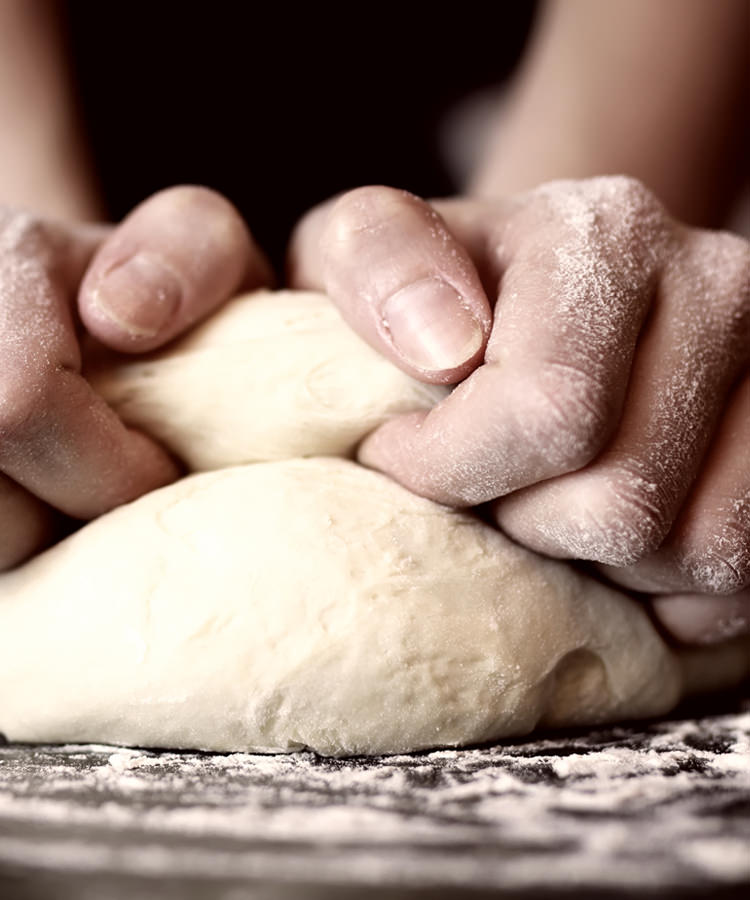Bread and wine have more in common than you’d think. Sure, they’ve been enjoyed together for millennia, feed billions daily, and feature prominently in the world’s major religious texts, but that’s not all. Despite endless variations in flavor, looks, and methodology, bread and wine have one more thing in common: fermentation. That’s right — even your Wonder Bread is fermented.
Bread isn’t alcoholic, but the same process that gives wine its delightful alcoholic kick is what gives bread its airy texture and signature rise. The process is almost identical to alcoholic fermentation: Yeast eats sugar and releases carbon dioxide. With beverages, that CO2 is released into the air, but in bread, gluten proteins trap the gas inside the dough, causing it to rise.
Even better, it’s fermentation you can recreate at home. When my own winemaking experience resulted in an epic fail, I decided to scale down my edible science lab. Taking things back from the garage into the kitchen, I decided to bake bread. And what I learned about winemaking from baking bread was more than a literal ton of Zinfandel and hours of foot treading combined could teach me.
Sourdough Fermentation
You don’t need heavy equipment or any training to make bread. You just need flour and water. To see the miracle of fermentation in action, mix equal parts flour and water — start with a cup of each — in a large bowl, and cover it. Leave it alone in a warm place, and over the course of 24 hours you’ll start to see bubbles in the mixture, like the bubbles in pancake batter. Every day over the course of a week, add more flour and more water. Gradually, the bubbles will multiply and even become frothy.
Those bubbles are carbon dioxide, and the first sign that fermentation is happening inside the floury slush. This is basic sourdough fermentation — the bread equivalent of making natural wine. Ambient yeast that live in the air are finding food and a new home in the flour mixture and starting to eat the sugar molecules inside the flour — a.k.a. fermenting — the dough. By slowly digesting the sugar, these yeast fundamentally change the flour, developing the tangy funk that makes sourdough unique.
Like natural wines, native yeast breads are delicate in their fermentations. If the temperature drops, the process happens at a painfully slow pace. If it gets too hot, the flavors don’t develop well. Sometimes these breads and native ferments taste just plain weird. Because native fermentations depend on wild yeast, which varies from place to place, no two sourdough cultures are exactly alike. As a result, you’ll see loaf-to-loaf variation, just like the bottle variation that’s inherent in natural wines.
Cultured Yeast Fermentation
To mimic conventional winemaking, which relies on cultured yeast, all it takes is a $2 packet of dried yeast. Put a pack of instant or rapid-rise yeast into a cup of warm water and watch. The bubbles that took a full day to develop on the counter will be active in as little as 15 minutes. Add flour, and rising takes no time at all.
While wineries choose their yeast strains from a massive catalog, even most small grocery stores carry several varieties of yeast. Quite simply, there’s massive variation in the organisms responsible for both bread and wine which provide the flavor variation that keeps both categories fascinating. With cultured yeast, like traditional wines, the process is easy, predictable and reliable every time.
Whichever yeast you choose, fermentation is happening in virtually every dough, and how it’s coaxed along will bring a range of flavors to the party. In the kitchen, it’s easy to recreate all the variations that make wine unique. The techniques that transform flour into a crisp baguette or dense rye loaf mimic the tools winemakers use, like acid, oak barrels, and aging regimens in wine.
Rye, whole wheat, or a mix of flours create variations in color, texture, and flavor in exactly the same way that different grape varieties or a blend of varieties change the flavor, body, and color of a wine. For example, working with extremely flavorful flours instead of plain, malleable white flour is like making Cabernet Sauvignon instead of Pinot Grigio; rising dough overnight in the fridge is equivalent to long, slow fermentations versus rapid, high-heat ones. Using a bread machine, electric mixer, or mixing by hand will all change the texture of bread the same way cellar techniques like battonage and barrel aging shape a wine. Adding nuts, seeds, dried fruit, milk, sugar, or other ingredients changes the bread’s flavor and texture, mirroring the choices winemakers make with wine additives on a large scale.
Whatever the combination of flours, yeast, and water the results will be different. Perhaps rising times will be longer or the dough stickier. Sometimes, the result might be hard as a rock, or delicate and delicious.
Each fermentation is different, and much like trying new wines, at-home dabbling in fermentation is all about curiosity and exploring new flavors. It’s a delicate miracle, and one some experts believe allowed humanity as we know it to flourish. So skip Bill Nye, complicated winemaking kits, and expensive winery tours, and head to the kitchen instead — with a glass of wine, of course.
